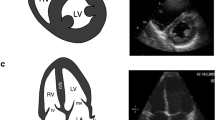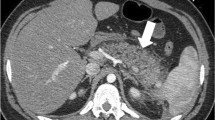Abstract
This study aims to evaluate the utility of compressed computed tomography (CT) studies (to expedite transmission) using Motion Pictures Experts Group, Layer 4 (MPEG-4) movie formatting in combat hospitals when guiding major treatment regimens. This retrospective analysis was approved by Walter Reed Army Medical Center institutional review board with a waiver for the informed consent requirement. Twenty-five CT chest, abdomen, and pelvis exams were converted from Digital Imaging and Communications in Medicine to MPEG-4 movie format at various compression ratios. Three board-certified radiologists reviewed various levels of compression on emergent CT findings on 25 combat casualties and compared with the interpretation of the original series. A Universal Trauma Window was selected at −200 HU level and 1,500 HU width, then compressed at three lossy levels. Sensitivities and specificities for each reviewer were calculated along with 95 % confidence intervals using the method of general estimating equations. The compression ratios compared were 171:1, 86:1, and 41:1 with combined sensitivities of 90 % (95 % confidence interval, 79–95), 94 % (87–97), and 100 % (93–100), respectively. Combined specificities were 100 % (85–100), 100 % (85–100), and 96 % (78–99), respectively. The introduction of CT in combat hospitals with increasing detectors and image data in recent military operations has increased the need for effective teleradiology; mandating compression technology. Image compression is currently used to transmit images from combat hospital to tertiary care centers with subspecialists and our study demonstrates MPEG-4 technology as a reasonable means of achieving such compression.

Similar content being viewed by others
References
Boone JM: Multidetector CT: opportunities, challenges, and concerns associated with scanners with 64 or more detector rows. Radiology 241(2):334–337, 2006
Goldberg MA, Pivovarov M, Mayo-Smith WW, Bhalla MP, "Blickman JG, Bramson RT, Boland GW, Llewellyn HJ, Halpern E: Application of wavelet compression to digitized radiographs. Am J Roentgenol 163(2):463–468, 1994
Savcenko V, Erickson BJ, Palisson PM, Persons KR, Manduca A, Hartman TE, Harms GF, Brown LR: Detection of subtle abnormalities on chest radiographs after irreversible compression. Radiology 206(3):609–616, 1998
Megibow AJ, Rusinek H, Lisi V, Bennett GL, Macari M, Israel GM, Krinsky GA: Computed tomography diagnosis utilizing compressed image data: an ROC analysis using acute appendicitis as a model. J Digit Imaging 15(2):84–90, 2002
Kallergi M, Lucier BJ, Berman CG, Hersh MR, Kim JJ, Szabunio MS, Clark RA: High-performance wavelet compression for mammography: localization response operating characteristic evaluation. Radiology 238(1):62–73, 2006
Chen TJ, Chuang KS, Wu J, Chen SC, Hwang IM, Jan ML: Quality degradation in lossy wavelet image compression. J Digit Imaging 16(2):210–215, 2003
Microsoft Healthvault www.healthvault.com. Accessed June 2012.
Microsoft Healthvault; Organize your medical records in one place. http://www.microsoft.com/en-us/healthvault/organize/medical-records.aspx. Accessed June 2012.
Folio LR: Combat radiology. Springer, NY, 2010
Shogan P, Folio L: “Microsoft healthvault: An electronic personal health record option for deployed military.” RSNA. LL-IN3510-L. Nov. 2009
Ko JP, Rusinek H, Naidich DP, McGuinness G, Rubinowitz AN, Leitman BS, Martino JM: Wavelet compression of low-dose chest CT data: effect on lung nodule detection. Radiology 228(1):70–75, 2003
Fahmy G, Black Jr, J, Panchanathan S: Texture characterization for joint compression and classification based on human perception in the wavelet domain. IEEE Trans Image Process 15(6):1389–1396, 2006
Savcenko V, Erickson BJ, Persons KR, Campeau NG, Huston 3rd, J, Wood CP, Schreiner SA: An evaluation of JPEG and JPEG 2000 irreversible compression algorithms applied to neurologic computed tomography and magnetic resonance images. J Digit Imaging 13(2 Suppl 1):183–185, 2000
Ringl H, Schernthaner RE, Kulinna-Cosentini C, Weber M, Schaefer-Prokop C, Herold CJ, Schima W: Lossy three-dimensional JPEG2000 compression of abdominal CT images: assessment of the visually lossless threshold and effect of compresnd. Environ Med 71(3):267, 2000
Folio L, Sneeder W: Applied telemedicine, teleconsultation and tele-education aboard USS George Washington Aircraft Carrier. Abstract. Aviation, Space, and Environmental Medicine, 71:3, March 2000, 267
Arnold CW, Bui AA, Morioka C, El-Saden S, Kangarloo H: Informatics in radiology a prototype web-based reporting system for onsite-offsite clinician communication. Radiographics 27(4):1201–1211, 2007
Poepping TL, Gill J, Fenster A, Holdsworth DW: MP3 compression of Doppler ultrasound signals. Ultrasound Med Biol 29(1):65–76, 2003
Gonzalez J, Cervera T, Llau MJ: Acoustic analysis of pathological voices compressed with MPEG system. J Voice 17(2):126–139, 2003
Gonzalez J, Cervera T: The effect of MPEG audio compression on multidimensional set of voice parameters. Logoped Phoniatr Vocol 26(3):124–138, 2001
Hinsley D. Protecting Those Who Serve; Teleradiology technology delivers quicker diagnoses for deployed troops. Imaging Economics. August 2005. http://www.imagingeconomics.com/issues/articles/MI_2005-08_02.asp. Accessed June 2012.
Acknowledgments
The authors would like to thank Cara Olsen, DrPH, of the Uniformed Services University for helping with her statistical expertise and data analysis.
Author information
Authors and Affiliations
Corresponding author
Additional information
The views expressed in this article are those of the authors and do not reflect the official policy or position of the Department of the Army, Department of Defense, or the U.S. Government.
Rights and permissions
About this article
Cite this article
Peterson, P.G., Pak, S.K., Nguyen, B. et al. Extreme Compression for Extreme Conditions: Pilot Study to Identify Optimal Compression of CT Images Using MPEG-4 Video Compression. J Digit Imaging 25, 764–770 (2012). https://doi.org/10.1007/s10278-012-9500-8
Published:
Issue Date:
DOI: https://doi.org/10.1007/s10278-012-9500-8




